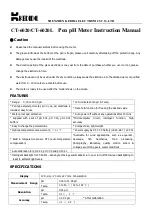
9.17.010
page 9
BRONKHORST
®
2.6 In-line filter
Although fluids and piping should be absolutely free from dirt, it is recommended to install inline filters
upstream of the flowmeter(s).
2.7 Fluid connections
The liquid meter should be installed according to its manual. The outlet of this meter should be connected to
the liquid input port of the CEM valve. The CEM valve is controlled by the controller section of the liquid
flowmeter. Electrical connections should be made according to the customer system description.
The outlet of the gas flow controller must be connected to the gas input part of the CEM valve.
The vapour outlet of the CEM should be directly coupled to the process, this tube should be heated at a
temperature higher than the heater in order to assure that the vapour will not condensate in this line. Avoid
“cold spots” in the outlet.
* Note:
Always check your system for leaks, before applying fluid pressure. Especially if toxic, explosive or
other dangerous fluids are used.
2.8 Electrical connections
Bronkhorst
®
recommends to use their standard cables, which have been tested together with the system.
These cables have the right connector, and if loose ends are used, these will be marked to prevent wrong
connection.
2.9 Caution
Each system is pressure tested to at least 1.5 times the working pressure of the process conditions
stipulated by the customer, with a minimum of 8 bar.
This test pressure is stated on the CEM valve with a Red Coloured sticker.
Check test pressure before installing in the line.
If this sticker is not available, or the test pressure is incorrect, the instrument should not be mounted in the
process line and be returned to the factory.
Each instrument is leak tested to at least 2
10
-9
mbar l/s Helium.
2.10 Supply pressure
Do not apply pressure until electrical connections are made. When applying pressure to the system, take
care to avoid pressure shocks in the system, and increase pressure gradually. Be sure that all set points are
at zero when doing so.
2.11 System purging
If corrosive or reactive fluids are used, purging with an inert gas is absolutely necessary, because if the
tubing has been exposed to air, introducing these fluids will tend to clog up or corrode the system due to a
chemical reaction with air or moist air.
Complete, long term purging is also required to remove such fluids from the system before exposing it to air.
It is preferred not to expose the system to air, when working with these corrosive fluids. Cycled purging and
evacuating is preferred.
2.12 Seals
Bronkhorst
®
has gathered a material compatibility chart from a number of sources believed to be reliable.
However, it is a general guide only. Operating conditions may substantially change the accuracy of this
guide. Therefore is no liability for damages accruing from the use of this guide. The customers application
demands its own specific design or test evaluation for optimum reliability. So check if the seals are correct
for your process. However the CEM system has metal seals for all connections. Only the valve plunger is an
elastomer.
Содержание CEM
Страница 2: ...page 2 9 17 010 BRONKHORST ...
Страница 6: ...page 6 9 17 010 BRONKHORST ...
Страница 13: ...APPENDIX Recommendations for handling the Bronkhorst DLI CEM system Vacuum system Non Vacuum system ...
Страница 14: ...BRONKHORST 1 ...




































